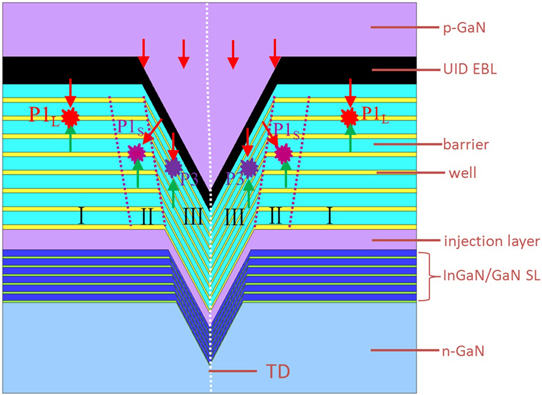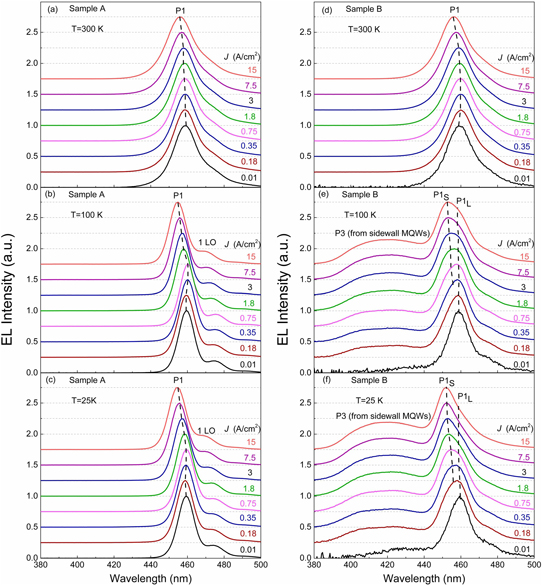Researchers at Nanchang University in China have been studying the effect of V-pits in indium gallium nitride (InGaN) light-emitting diodes (LEDs) on electroluminescence [Xiaoming Wu, Junlin Liu, and Fengyi Jiang, J. Appl. Phys., vol118, p164504, 2015].

Figure 1: Schematic diagram of hole injection from sidewall of V-pits into c-plane MQWs. Red and green arrows represent hole and electron current, respectively. For clarity, c-plane MQWs between the two dashed lines illustrate regions where emission wavelength is affected by V-pit. In real devices, c-plane MQWs closer to V-pits are more affected by V-pits and there might be no definite boundary.
Spectral analysis at low temperature (100K and 25K) showed a broad short-wavelength peak that the researchers attribute to a new hole injection mechanism from the V-pit sidewalls into the c-plane InGaN/GaN multiple quantum well (MQW) structure (Figure 1). The effect was only seen in samples where the aluminium gallium nitride (AlGaN) electron-blocking layer (EBL) was unintentionally doped (UID) (Figure 2).

Figure 2: Electroluminescence spectra of samples with heavily doped (A) and UID (B) EBLs at various temperatures. Each spectrum was normalized to its own peak height. Main MQW peak (P1) broadens in sample B at 100K and 25 K. P1S and P1L represent the short- and long-wavelength parts of P1, respectively.
The researchers comment: "Though this hole injection mechanism is observed in the sample with UID EBL and at cryogenic temperatures, it may also exist in normal devices at room temperature and be significant to the device performance, which deserves intensive study."
The MQWs were grown at the relatively low temperature of 850°C. In InGaN MQW structures, V-pits tend to form above threading dislocations.
At room temperature (300K), V-pits that form on top of threading dislocations are thought to create MQWs with a wider bandgap that act as barriers to carriers reaching the dislocations. If carriers interact with dislocations, they tend to recombine non-radiatively, reducing efficiency.
Previous simulations by the Nanchang team suggested that hole injection could be increased due to lower effective hole barrier height, resulting from reduced piezoelectric charges on semi-polar facets of the V-pits. Also, the EBL is much thinner on the V-pit sidewalls – EBLs also partially block hole injection.
The researchers see two factors as blocking hole injection via the V-pits with unintentionally doped EBLs at room temperature:
1. The EBL resistance is not high enough to compensate for the increased barrier of the sidewall MQWs;
2. Increased non-radiative recombination of holes at the dislocations at room temperature, compared with low temperature operation.

